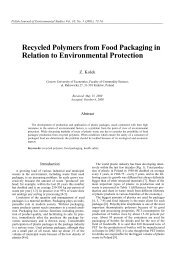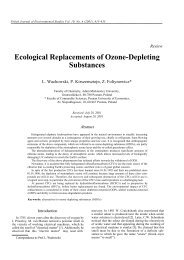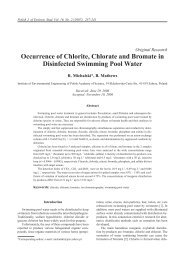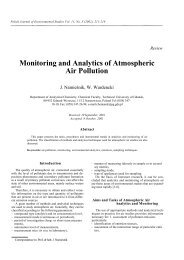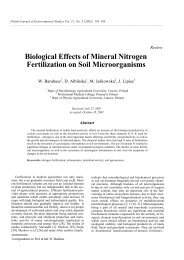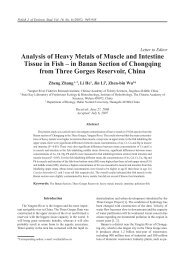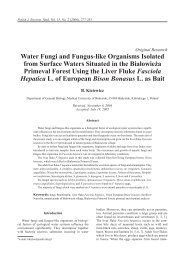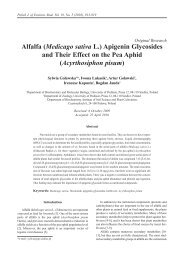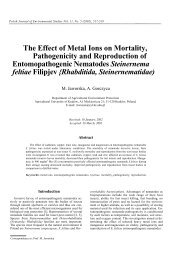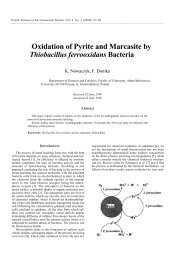Removal of Iron and Manganese from Water Using Filtration by ...
Removal of Iron and Manganese from Water Using Filtration by ...
Removal of Iron and Manganese from Water Using Filtration by ...
Create successful ePaper yourself
Turn your PDF publications into a flip-book with our unique Google optimized e-Paper software.
Polish J. <strong>of</strong> Environ. Stud. Vol. 19, No. 6 (2010), 1117-1122<br />
Original Research<br />
<strong>Removal</strong> <strong>of</strong> <strong>Iron</strong> <strong>and</strong> <strong>Manganese</strong> <strong>from</strong> <strong>Water</strong><br />
<strong>Using</strong> <strong>Filtration</strong> <strong>by</strong> Natural Materials<br />
Danka Barloková*, Ján Ilavský**<br />
Department <strong>of</strong> Sanitary <strong>and</strong> Environmental Engineering,<br />
Faculty <strong>of</strong> Civil Engineering, Slovak University <strong>of</strong> Technology,<br />
Radlinského 11, 813 68 Bratislava, Slovakia<br />
Received: 13 August 2009<br />
Accepted: 19 October 2009<br />
Abstract<br />
In many cases, water intended for drinking purposes must be treated in order to meet the requirements<br />
<strong>of</strong> Regulation <strong>of</strong> the Government <strong>of</strong> the Slovak Republic No. 354/2006 on drinking water. There is a tendency<br />
to find more efficient <strong>and</strong> cost-effective materials <strong>and</strong> technologies used in water treatment. The goal <strong>of</strong> this<br />
study is to compare activated natural zeolite-clinoptilolite with activated filtration s<strong>and</strong> <strong>and</strong> the imported material<br />
Birm (<strong>from</strong> the Clack Corporation, USA) in removal <strong>of</strong> iron <strong>and</strong> manganese <strong>from</strong> water. Obtained results<br />
carried out in the water treatment plant in Holíč prove that Klinopur-Mn is suitable for removal <strong>of</strong> iron <strong>and</strong><br />
manganese <strong>from</strong> water <strong>and</strong> is comparable with other imported materials.<br />
Keywords: removal <strong>of</strong> iron <strong>and</strong> manganese <strong>from</strong> water, contact filtration, natural materials, clinoptilolite,<br />
modified clinoptilolite, drinking water<br />
Introduction<br />
Groundwater is the most common resource <strong>of</strong> drinking<br />
water in Slovakia (83.9 percent <strong>of</strong> the population is supplied<br />
with drinking water <strong>from</strong> ground resources). In localities<br />
without a quality drinking water resource (groundwater),<br />
the surface water is used for this purpose or water<br />
<strong>from</strong> an other locality is supplied through long-distance<br />
distribution systems [1]. In 2006 there were 5,507 groundwater<br />
resources registered in Slovakia. On average, the<br />
amount <strong>of</strong> 11.665 l·s -1 was used (8.836 l·s -1 for water supply),<br />
including 2.63 l·s -1 that is required to be treated. The<br />
treatment is mostly related to undesirable concentrations <strong>of</strong><br />
iron <strong>and</strong> manganese. According to the 2006 Report on the<br />
Environment in Slovakia, the concentration <strong>of</strong> iron<br />
exceeded the limit 0.2 mg·l -1 in more than 36.5 % <strong>of</strong> samples,<br />
<strong>and</strong> the concentration <strong>of</strong> manganese exceeded the<br />
*e-mail: danka.barlokova@stuba.sk<br />
**e-mail: jan.ilavsky@stuba.sk<br />
limit 0.05 mg·l -1 in more than 40.1% <strong>of</strong> groundwater samples.<br />
The limit values are defined under the Regulation <strong>of</strong><br />
the Government <strong>of</strong> Slovak Republic No. 354/2006 specifying<br />
the requirements on water intended for human consumption<br />
<strong>and</strong> quality <strong>of</strong> water intended for human consumption<br />
[2].<br />
Forms <strong>of</strong> Occurrence <strong>of</strong> <strong>Iron</strong><br />
<strong>and</strong> <strong>Manganese</strong> in <strong>Water</strong><br />
<strong>Iron</strong> <strong>and</strong> manganese occur in dissolved forms as single<br />
ions (Fe 2+ , Mn 2+ ) or in undissolved higher forms mainly as<br />
Fe(OH) 3 or Mn(OH) 4 , respectively. They can also be present<br />
in colloid form (bound to humic substances). The form<br />
<strong>of</strong> their occurrence depends on oxygen concentration, solubility<br />
<strong>of</strong> Fe <strong>and</strong> Mn compounds in water, pH value, redox<br />
potential, hydrolysis, the presence <strong>of</strong> complex-forming<br />
inorganic <strong>and</strong> organic substances, water temperature, <strong>and</strong><br />
water composition (e.g. CO 2 content).
1118 Barloková D., Ilavský J.<br />
Effect on <strong>Water</strong> Quality<br />
Adverse effects <strong>of</strong> higher Fe <strong>and</strong> Mn concentrations in<br />
drinking water can be summarized as follows:<br />
1. iron (II) <strong>and</strong> manganese (II) ions are oxidized to higher<br />
forms in a water distribution system <strong>and</strong> this results in<br />
the formation <strong>of</strong> hydroxide suspensions causing undesirable<br />
turbidity <strong>and</strong> colour <strong>of</strong> water,<br />
2. the presence <strong>of</strong> iron <strong>and</strong> manganese bacteria in water<br />
supply system causes change in water quality (smell)<br />
<strong>and</strong> bacterial growth in pipes,<br />
3. in the case <strong>of</strong> the occurrence <strong>of</strong> iron (II) <strong>and</strong> manganese<br />
(II) ions at the consumer’s point, iron <strong>and</strong> manganese<br />
are oxidized <strong>and</strong> precipitated under suitable conditions<br />
(e.g. in washing machines, boilers).<br />
Following the above-mentioned facts, higher concentrations<br />
<strong>of</strong> iron <strong>and</strong> manganese in water cause technological<br />
problems, failure <strong>of</strong> water supply systems operation, water<br />
quality deterioration <strong>and</strong>, in water with slightly higher concentrations<br />
<strong>of</strong> oxygen, they form undesirable incrustations<br />
that result in the reduction <strong>of</strong> pipe flow cross-section.<br />
Methods <strong>of</strong> <strong>Iron</strong> <strong>and</strong> <strong>Manganese</strong> <strong>Removal</strong><br />
The principle <strong>of</strong> most methods used for iron <strong>and</strong> manganese<br />
removal is that originally dissolved iron <strong>and</strong> manganese<br />
are transformed into undissolved compounds that<br />
can be removed through single-stage or two-stage separation.<br />
Oxidation <strong>and</strong> hydrolysis <strong>of</strong> these compounds is done<br />
under strict conditions with respect to water properties <strong>and</strong><br />
type <strong>of</strong> equipment for iron <strong>and</strong> manganese removal.<br />
Single-stage water treatment (filtration) is designed for<br />
iron <strong>and</strong> manganese concentrations to 5 mg·l -1 , <strong>and</strong> the twostage<br />
treatment (settling tanks or clarifiers <strong>and</strong> filters) is<br />
used for water with iron <strong>and</strong> manganese concentrations<br />
higher than 5 mg·l -1 . In case water contains higher concentrations<br />
<strong>of</strong> Ca, Mg, <strong>and</strong> CO 2 (eventually H 2 S), aeration is<br />
done before settling or filtration.<br />
<strong>Removal</strong> <strong>of</strong> Fe <strong>and</strong> Mn <strong>from</strong> groundwater <strong>and</strong> surface<br />
water can be done <strong>by</strong> several methods:<br />
• oxidation <strong>by</strong> aeration,<br />
• removal <strong>of</strong> Fe <strong>and</strong> Mn <strong>by</strong> oxidizing agents (O 2 , Cl 2 , O 3 ,<br />
KMnO 4 ),<br />
• removal <strong>of</strong> Fe <strong>and</strong> Mn <strong>by</strong> alkalinization (<strong>by</strong> adding the<br />
lime),<br />
• contact filtration for removal <strong>of</strong> Fe <strong>and</strong> Mn,<br />
• removal <strong>of</strong> Fe <strong>and</strong> Mn <strong>by</strong> ion exchange,<br />
• removal <strong>of</strong> Fe <strong>and</strong> Mn using membrane processes,<br />
• removal <strong>of</strong> Fe <strong>and</strong> Mn using biological filtration,<br />
• removal <strong>of</strong> Fe <strong>and</strong> Mn using in situ method.<br />
Fe 2+ <strong>and</strong> Mn 2+ oxidation rate as well as hydrolysis <strong>of</strong><br />
emerging oxides <strong>of</strong> higher iron <strong>and</strong> manganese oxidation<br />
forms in groundwater depends on the pH value. Various<br />
graphic dependencies <strong>of</strong> these relationships with respect to<br />
oxidation time are listed in literature. The pH value should<br />
be equal or greater than 7 in removal <strong>of</strong> iron <strong>from</strong> groundwater.<br />
For removal <strong>of</strong> manganese without catalyst, the pH<br />
value should be equal to or greater than 8 [3].<br />
<strong>Removal</strong> <strong>by</strong> using the oxidized film on grains <strong>of</strong> filter<br />
medium is one method for elimination <strong>of</strong> dissolved manganese.<br />
The film is formed on the surface <strong>of</strong> filter medium<br />
<strong>by</strong> adding permanganate potassium (not only KMnO 4 but<br />
also other strong oxidizing agents). The film serves as a catalyst<br />
for the oxidation process. Grains <strong>of</strong> filter medium are<br />
covered <strong>by</strong> higher oxides <strong>of</strong> metals. In such a case, it is<br />
related to special filtration so-called “contact filtration” –<br />
filtration <strong>by</strong> using manganese filters. The oxidation state <strong>of</strong><br />
the film <strong>of</strong> MnO x (s) filter medium is important in removal<br />
<strong>of</strong> dissolved manganese. <strong>Manganese</strong> removal efficiency is<br />
a direct function <strong>of</strong> MnO x (s) concentration <strong>and</strong> its oxidation<br />
state. The films with different ability to remove dissolved<br />
manganese <strong>from</strong> water are formed on the surface <strong>of</strong> various<br />
filter media [4-8].<br />
Natural or synthetic zeolite can be used as a filtration<br />
material for removal <strong>of</strong> iron <strong>and</strong> manganese <strong>from</strong> water.<br />
Birm, Greens<strong>and</strong>, Pyrolox, <strong>and</strong> MTM are the most frequently<br />
used materials in filtration.<br />
Birm is a granulated filter medium (imported <strong>from</strong> the<br />
USA) used for iron <strong>and</strong> manganese removal <strong>from</strong> water. It<br />
is a specially developed material containing MnO 2 film on<br />
the surface (catalyst). It is recommended to use Birm for<br />
lower iron concentrations (to Fe 2+ concentration <strong>of</strong> 6.0 mg·l -1<br />
<strong>and</strong> Mn 2+ about 3.0 mg·l -1 ) <strong>and</strong> for household water treatment.<br />
It can also be used in gravity or pressure filters.<br />
Contact with filter material results in oxidation <strong>of</strong> dissolved<br />
iron <strong>and</strong> manganese. Subsequently, precipitated Fe<br />
<strong>and</strong> Mn hydroxides (pH <strong>of</strong> 8 to 9 is required for Mn<br />
removal) are easily removed <strong>by</strong> filtration. Filter medium is<br />
cleaned <strong>by</strong> backwashing. There is no need <strong>of</strong> chemical<br />
regeneration. In cleaning process the time <strong>of</strong> backwashing<br />
<strong>and</strong> wash water velocity are important factors. Long service<br />
life is also one <strong>of</strong> the advantages <strong>of</strong> this medium.<br />
Klinopur-Mn is produced in Slovakia <strong>from</strong> natural zeolites.<br />
It is an activated zeolite-clinoptilolite (rich deposits <strong>of</strong><br />
clinoptilolite are in the East Slovakia Region).<br />
Mineralogical <strong>and</strong> chemical analysis <strong>of</strong> zeolite <strong>from</strong> the<br />
Nižný Hrabovec deposit are listed in Tables 1 <strong>and</strong> 2.<br />
On the surface <strong>of</strong> clinoptilolite grains there is a factorymade<br />
film consisting <strong>of</strong> manganese oxides (MnO x ) which<br />
enable this material to be used in the contact filtration. The<br />
filter material is produced <strong>by</strong> Zeocem Bystré <strong>and</strong> it is much<br />
cheaper compared to materials imported <strong>from</strong> the USA.<br />
Table 1. Mineralogical analysis <strong>of</strong> zeolite <strong>from</strong> the Nižný<br />
Hrabovec deposit.<br />
Mineral Content [%]<br />
Clinoptilolite 84<br />
Cristobalite 8<br />
Feldspar 3-4<br />
Illite 4<br />
Crystal<br />
traces<br />
Carbonate minerals traces (
<strong>Removal</strong> <strong>of</strong> <strong>Iron</strong> <strong>and</strong> <strong>Manganese</strong> <strong>from</strong> <strong>Water</strong>... 1119<br />
Table 2. Chemical analysis <strong>of</strong> clinoptilolite <strong>from</strong> the Nižný<br />
Hrabovec deposit.<br />
Compound Content % Compound Content %<br />
SiO 2 66.4 MgO 0.56<br />
Al 2 O 3 12.2 Na 2 O 0.29<br />
K 2 O 3.33 MnO 0.02<br />
CaO 3.04 TiO 2 0.15<br />
Fe 2 O 3 1.45 P 2 O 5 0.02<br />
Table 3. <strong>Filtration</strong> materials <strong>and</strong> some selected parameters.<br />
Material Clinoptilolite Birm Greens<strong>and</strong> <strong>Filtration</strong><br />
s<strong>and</strong><br />
Grain size<br />
[mm]<br />
0.3-2.5 0.48-2.0 0.25-0.8 0.7-2.0<br />
Specific<br />
gravity<br />
[g·cm -3 ]<br />
2.39 2.0 2.4-2.9 2.66<br />
Apparent<br />
density<br />
[g·cm -3 ]<br />
0.84 0.7-0.8 1.36 1.55<br />
Porosity [%] 64.8 - - 41.7<br />
Abrasion [%] 8.2 - - 0.57<br />
Based on experiments (pilot tests) performed <strong>by</strong> experts <strong>of</strong><br />
the Department <strong>of</strong> Sanitary <strong>and</strong> Environmental Engineering<br />
at the Faculty <strong>of</strong> Civil Engineering <strong>of</strong> the University <strong>of</strong><br />
Technology in Bratislava, as well as experts <strong>of</strong> the <strong>Water</strong><br />
Research Institute Bratislava, it can be stated that the surface<br />
<strong>of</strong> clinoptilolite activated <strong>by</strong> manganese oxides is comparable<br />
with imported Birm, <strong>and</strong> it is possible to use it for<br />
removal <strong>of</strong> Fe <strong>and</strong> Mn <strong>from</strong> water.<br />
Clinoptilolite (NaK) 6 (Al 6 Si 30 O 72 )·20H 2 O is one <strong>of</strong> the<br />
most frequently used natural zeolites. At present it is also<br />
applied to the water treatment process. Sufficient mechanical<br />
resistance, chemical stability, <strong>and</strong> abrasion values (even<br />
if they categorize it among s<strong>of</strong>t materials) enable clinoptilolite<br />
to be used as a filtration material.<br />
The specific weight <strong>of</strong> clinoptilolite is lower than the<br />
weight <strong>of</strong> silica s<strong>and</strong>. Moreover, its porosity <strong>and</strong> sludge<br />
capacity are 1.5 times greater compared to filtration s<strong>and</strong>.<br />
<strong>Using</strong> the zeolite in slow s<strong>and</strong> filtration allows filtration rate<br />
to be increased <strong>by</strong> four times. Furthermore, it also reduces<br />
the amount <strong>of</strong> wash water <strong>and</strong> time needed for filter backwashing<br />
[9].<br />
Properties <strong>of</strong> some filtration materials used for removal<br />
<strong>of</strong> manganese <strong>and</strong> iron are listed in Table 3.<br />
Experimental Procedures<br />
The objective <strong>of</strong> the study conducted at the Holíč <strong>Water</strong><br />
Treatment Plant was to compare the efficiency <strong>of</strong> iron <strong>and</strong><br />
manganese removal in the water treatment process using<br />
filter material on the basis <strong>of</strong> chemically activated natural<br />
zeolite (Klinopur-Mn) produced in Slovakia with imported<br />
Birm that is commonly used abroad to remove dissolved<br />
iron <strong>and</strong> manganese <strong>from</strong> water, mainly for small water<br />
resources or with modified filtration s<strong>and</strong> used directly in<br />
the water treatment plant. It was important also to monitor<br />
the time <strong>of</strong> single filtration cycles, regeneration <strong>of</strong> filter<br />
materials <strong>by</strong> using potassium permanganate, <strong>and</strong> the<br />
amount <strong>of</strong> water used for filter backwashing.<br />
<strong>Water</strong> Treatment Model<br />
To verify the efficiency <strong>of</strong> iron <strong>and</strong> manganese removal<br />
<strong>from</strong> water resource in the town <strong>of</strong> Holíč, three filtration<br />
columns containing Birm, Klinopur-Mn, <strong>and</strong> filtration<br />
s<strong>and</strong> were used. The adsorption column was made <strong>of</strong> glass.<br />
Table 4. Results <strong>of</strong> raw water chemical analysis.<br />
Parameter Unit Raw water Parameter Unit Raw water<br />
pH 8.30<br />
+<br />
NH 4 mg·l -1 0.81<br />
conductivity mS·m -1 65 Fe total mg·l -1 0.48<br />
colour mg·l -1 Pt 38 Mn mg·l -1 0.42<br />
turbidity FTU 7 Na + mg·l -1 25.77<br />
Alkalinity (ANC) mmol·l -1 4.34 Ca 2+ mg·l -1 103.1<br />
Acidity (BNC) mmol·l -1 1.32 Mg 2+ mg·l -1 24.74<br />
Ca+Mg mmol·l -1 3.59 Cl¯ mg·l -1 59.68<br />
CHSK Mn mg·l -1 1.68 NO 3¯ mg·l -1 1.21<br />
TOC mg·l -1 3.0<br />
2-<br />
SO 4 mg·l -1 165.4<br />
Insoluble substances mg·l -1 24 HCO 3¯ mg·l -1 264.7<br />
Soluble substances mg·l -1 470 CO 2 mg·l -1 27.28
1120 Barloková D., Ilavský J.<br />
Table 5. <strong>Filtration</strong> conditions.<br />
Parameter Klinopur-Mn Birm <strong>Filtration</strong> s<strong>and</strong><br />
Grain size [mm] 1.0-2.0 1.0-2.0 1.0-2.0<br />
Height <strong>of</strong> filtration medium [cm] 120 120 120<br />
Volume <strong>of</strong> filtration medium [cm 3 ] 2356 2356 2356<br />
Average discharge through column [ml·min -1 ] 172.6 173.6 174.6<br />
Average filtration rate [m·hour -1 ] 5.27 5.30 5.33<br />
Total filtration time [hour] 1194 1194 1194<br />
Total volume <strong>of</strong> water flown through [m 3 ] 12.300 12.374 12.447<br />
Average active bed volume [BV·hour -1 ] 4.395 4.421 4.445<br />
Average residence time in column [min] 13.65 13.57 13.50<br />
The parameters <strong>of</strong> adsorption column are as follows: diameter<br />
= 5.0 cm; height = 2 m; surface = 19.635 cm 2 ; filtration<br />
medium height = 120.0 cm.<br />
Raw <strong>Water</strong> Chemical Analysis<br />
Based on water analyses carried out during these tests,<br />
the iron <strong>and</strong> manganese concentrations in raw water after<br />
aeration <strong>and</strong> sedimentation ranged <strong>from</strong> 0.36 to 0.68 mg·l -1<br />
<strong>of</strong> Fe (average value 0.46 mg·l -1 l <strong>of</strong> Fe) <strong>and</strong> 0.39 to 0.56<br />
mg·l -1 <strong>of</strong> Mn (average value 0.41 mg·l -1 <strong>of</strong> Mn). pH value<br />
ranged <strong>from</strong> 8.26 to 8.38 (average value 8.3). The results <strong>of</strong><br />
analysis <strong>of</strong> raw water are listed in Table 4 (it is an analysis<br />
<strong>of</strong> some selected parameters).<br />
<strong>Filtration</strong> Conditions<br />
Raw water passed through the filtration columns in<br />
downward direction <strong>and</strong> the average filtration rate was in<br />
the range <strong>from</strong> 5.27 m·hour -1 to 5.33 m·hour -1 . The total<br />
time <strong>of</strong> filtration <strong>of</strong> raw water was 1,194 hours, total volume<br />
<strong>of</strong> water filtered during this period was in the range<br />
12.3 m 3 to 12.447 m 3 . <strong>Filtration</strong> conditions are shown in<br />
Table 5.<br />
The quality <strong>of</strong> raw water (Fe <strong>and</strong> Mn content) <strong>and</strong> treated<br />
water at outlets <strong>from</strong> separate filtration columns was monitored<br />
during the experiments. At the same time, the amount<br />
<strong>of</strong> water at inlets to filtration columns <strong>and</strong> water discharge at<br />
outlets <strong>from</strong> the columns were measured <strong>by</strong> water meter.<br />
Results <strong>and</strong> Discussion<br />
The results <strong>of</strong> experiments are best described <strong>by</strong> Figs. 1<br />
<strong>and</strong> 2 showing iron <strong>and</strong> manganese concentrations in raw<br />
water (RW), <strong>and</strong> values measured after water passed filtration<br />
materials. The figures also show the limit value for<br />
manganese (0.05 mg·l -1 ) <strong>and</strong> iron (0.2 mg·l -1 ) in drinking<br />
water pursuant to Government Regulation No. 354/2006<br />
Coll. Regeneration time <strong>of</strong> filtration media is indicated <strong>by</strong><br />
the arrow.<br />
In the first cycle (time between regeneration) the concentration<br />
<strong>of</strong> manganese exceeded the limit value in treated<br />
water after 148 hours <strong>of</strong> operation, in the second cycle after<br />
281 hours <strong>and</strong> in the third cycle after 462 hours during filtration<br />
<strong>by</strong> Klinopur-Mn <strong>and</strong> Birm (Table 6).<br />
<strong>Filtration</strong> media were backwashed approximately once<br />
every three days (according to the amount <strong>of</strong> precipitated<br />
ferric hydroxide trapped in a filter). After some time, as can<br />
be seen in Fig. 1, the concentration <strong>of</strong> manganese in treated<br />
water increased to 0.05 mg·l -1 after filtration <strong>by</strong> Klinopur-<br />
Mn (Birm), then the filtration medium was regenerated <strong>by</strong><br />
potassium permanganate solution (0.5% solution). After<br />
regeneration, the values <strong>of</strong> dissolved manganese were in<br />
compliance with the Regulation <strong>of</strong> the Government <strong>of</strong> the<br />
Slovak Republic No. 354/2006.<br />
Mn [mg/l]<br />
0.6<br />
0.5<br />
0.4<br />
0.3<br />
0.2<br />
0.1<br />
0.0<br />
0.7<br />
0.6<br />
0.5<br />
0.4<br />
0.3<br />
0.2<br />
0.1<br />
0.0<br />
Regeneration<br />
RW<br />
0 184 354 540 710 883 1,040 1,190<br />
Time [hrs.]<br />
Klinopur Birm S<strong>and</strong> Raw water Limit<br />
Fig. 1. <strong>Manganese</strong> removal process during water filtration in<br />
Holíč.<br />
Fe [mg/l]<br />
0 84 219 324 467 564 657 760 908 1,000 1,149<br />
Time [hrs.]<br />
RW<br />
Klinopur Birm S<strong>and</strong> Raw water Limit<br />
Fig. 2. <strong>Iron</strong> removal process during water filtration in Holíč.
<strong>Removal</strong> <strong>of</strong> <strong>Iron</strong> <strong>and</strong> <strong>Manganese</strong> <strong>from</strong> <strong>Water</strong>... 1121<br />
Table 6. <strong>Filtration</strong> time during filtration with material Klinopur-<br />
Mn or Birm.<br />
<strong>Filtration</strong><br />
cycle<br />
<strong>Filtration</strong> total<br />
time<br />
[hour]<br />
<strong>Filtration</strong> time until exceeding<br />
the limit 0.05 mg·l -1 [hour]<br />
Klinopur-Mn<br />
Birm<br />
1 st cycle 283 148 160<br />
2 nd cycle 371 281 281<br />
3 rd cycle 540 462 397<br />
Table 7. Amount <strong>of</strong> filtered water during filtration with material<br />
Klinopur-Mn or Birm.<br />
<strong>Filtration</strong><br />
cycle<br />
Total amount <strong>of</strong> filtered<br />
water<br />
[m 3 ]<br />
Amount <strong>of</strong> filtered water<br />
until exceeding the limit<br />
0.05 mg·l -1 [m 3 ]<br />
Klinopur-Mn Birm Klinopur-Mn Birm<br />
1 st cycle 2.844 2.858 1.487 1.615<br />
2 nd cycle 3.896 3.925 2.937 2.959<br />
3 rd cycle 5.560 5.591 4.734 4.068<br />
<strong>Filtration</strong> time period without regeneration was gradually<br />
extended. It means that industrially activated clinoptilolite<br />
(Klinopur-Mn) is necessary to be used several times<br />
directly on site, which will result in prolonged filtration<br />
cycles. After some time no regeneration will be required<br />
(analogous to modified filtration s<strong>and</strong>).<br />
Measured values <strong>of</strong> water filtered through the filtration<br />
column with Klinopur-Mn <strong>and</strong> Birm, calculated bed volumes<br />
– volume <strong>of</strong> the water passed through filtration column<br />
(V) to volume <strong>of</strong> the adsorption column (V 0 ) <strong>and</strong> efficiency<br />
<strong>of</strong> manganese removal (considering limit value 0.05<br />
mg·l -1 Mn) in individual cycles are shown in Tables 7 <strong>and</strong> 8.<br />
Klinopur-Mn can also be used for removal <strong>of</strong> iron <strong>from</strong><br />
water. Our results show that during the whole period <strong>of</strong><br />
measurements (1,194 hours), iron concentration did not<br />
exceed the limit value 0.2 mg·l -1 specified pursuant to<br />
Government Regulation No. 354/2006 (Fig. 2). The efficiency<br />
<strong>of</strong> iron elimination raw water in Holíč is comparable<br />
to Birm or modified filtration s<strong>and</strong>.<br />
In addition to Mn concentrations, the amount <strong>of</strong> water<br />
needed for backwashing both materials for the time period<br />
(10 minutes) <strong>and</strong> the height (elevation) <strong>of</strong> filter medium<br />
during the backwashing were monitored at the outlet <strong>from</strong><br />
filtration columns. The amount <strong>of</strong> water required for washing<br />
the Klinopur was lower <strong>by</strong> 1/3 compared to filtration<br />
s<strong>and</strong> – Table 9.<br />
For filtration, a bed <strong>of</strong> Klinopur-Mn was observed<br />
exp<strong>and</strong>ing during backwashing. Backwash bed expansion<br />
is presented in Fig. 3.<br />
Conclusions<br />
Obtained results prove the possibility <strong>of</strong> using<br />
Klinopur-Mn for removal <strong>of</strong> iron <strong>and</strong> manganese in the<br />
water treatment process. Klinopur-Mn is comparable with<br />
imported filtration material Birm. The results also show that<br />
the repeated use <strong>of</strong> Klinopur-Mn leads to extended filtration<br />
cycles <strong>and</strong> based on this fact it is comparable with prepared<br />
filtration s<strong>and</strong>. In comparison with filtration s<strong>and</strong>, the<br />
advantage <strong>of</strong> Klinopur-Mn is that it requires a lower<br />
amount <strong>of</strong> water for backwashing, which results in a more<br />
cost-effective operation.<br />
Expansion <strong>of</strong> bed [cm]<br />
50<br />
40<br />
30<br />
20<br />
10<br />
4.7<br />
10.0<br />
16.0<br />
21.5<br />
26.5<br />
32.0<br />
38.0<br />
y = 5.4893x - 0.7393<br />
R 2 = 0.9997<br />
43.0<br />
0<br />
500 760 900 1,040 1,120 1,240 1,360 1,470<br />
flow rate [ml/min]<br />
Fig. 3. Backwash bed expansion <strong>of</strong> Klinopur-Mn.<br />
Table 8. Efficiency <strong>of</strong> Mn removal in individual cycles considering bed volumes.<br />
<strong>Filtration</strong> cycle<br />
Total bed volume<br />
BV = V/V 0<br />
BV until exceeding the limit<br />
<strong>Filtration</strong> efficiency<br />
0.05 mg·l -1 [%]<br />
Klinopur Birm Klinopur Birm Klinopur Birm<br />
1 st cycle 1,207 1,213 631 686 52.28 56.55<br />
2 nd cycle 1,653 1,666 1,264 1,256 76.46 75.39<br />
3 rd cycle 2,360 2,373 2,009 1,727 85.13 72.78<br />
Table 9. Amount <strong>of</strong> water required for washing filtration materials.<br />
Parameter Klinopur-Mn <strong>Filtration</strong> s<strong>and</strong><br />
Average volume <strong>of</strong> wash water [m 3 ] for one backwashing <strong>of</strong> filter column 0.228 0.328
1122 Barloková D., Ilavský J.<br />
The content <strong>and</strong> form <strong>of</strong> occurrence <strong>of</strong> iron <strong>and</strong> manganese<br />
in water, as well as water pH <strong>and</strong> dissolved oxygen<br />
concentration (min. 15% <strong>of</strong> Fe+Mn content), are among the<br />
important criteria for Fe <strong>and</strong> Mn removal efficiency (lower<br />
efficiency in removal <strong>of</strong> iron bound to humic acids). The<br />
efficiency <strong>of</strong> Mn removal is influenced <strong>by</strong> the contact time<br />
between water <strong>and</strong> filter material (height <strong>of</strong> filtration layer,<br />
filtration time), properties <strong>of</strong> preparation active layer, i.e.<br />
layer thickness <strong>and</strong> its chemical composition, regeneration<br />
method, KMnO 4 concentration, plus times for backwashing<br />
<strong>and</strong> regeneration.<br />
Acknowledgements<br />
This work was supported <strong>by</strong> the Slovak Research <strong>and</strong><br />
Development Agency under contract No. APVV-0379-07.<br />
At the same time we would like to thank the staff <strong>of</strong> the<br />
company Bratislava <strong>Water</strong> Company in Holíč for help with<br />
our experiments.<br />
References<br />
1. KRIŠ J., DUBOVÁ V. Trends in Economical Treatment <strong>of</strong><br />
<strong>Water</strong>. In: Proceedings <strong>of</strong> the New Trends in <strong>Water</strong><br />
Management, Trenčín, ISBN 80-227-2251-0, pp. 20-25, 2005.<br />
2. 2006 Report on the Environment in Slovakia, 2006.<br />
3. ILAVSKÝ J., BARLOKOVÁ D., BISKUPIČ F. Chémia<br />
vody a hydrobiológia, STU Bratislava, ISBN 978-80-227-<br />
2930-7, pp. 303, 2008.<br />
4. DOULA, MARIA K. <strong>Removal</strong> <strong>of</strong> Mn 2+ Ions <strong>from</strong><br />
Drinking <strong>Water</strong> <strong>by</strong> <strong>Using</strong> Clinoptilolite <strong>and</strong><br />
Clinoptilolite-Fe Oxide System. <strong>Water</strong> Research, 40, (17),<br />
3167, 2006.<br />
5. KNOCKE W.R., VAN BENSCHOTEN J.E., KEARNEY<br />
M. J., SOBORSKI A. W., RECKHOW D. A. Kinetics <strong>of</strong><br />
<strong>Manganese</strong> <strong>and</strong> <strong>Iron</strong> Oxidation <strong>by</strong> Potassium<br />
Permanganate <strong>and</strong> Chlorine Dioxide. Jour. AWWA 6, 80,<br />
1991.<br />
6. KNOCKE W.R., OCCIANO S. C., HUNGATE R. <strong>Removal</strong><br />
<strong>of</strong> Soluble <strong>Manganese</strong> <strong>by</strong> Oxide-Coated Filter Media:<br />
Sorption Rate <strong>and</strong> <strong>Removal</strong> Mechanism Issues. J. AWWA 8,<br />
64, 1991.<br />
7. KNOCKE W.R., HAMON J.R., THOMPSON C.P. Soluble<br />
<strong>Manganese</strong> <strong>Removal</strong> on Oxide-Coated Filter Media. Jour.<br />
AWWA 12, 65, 1988.<br />
8. MERKLE P.B., KNOCKE W.R., GALLAGHER D.<br />
Characterizing Filter Media Mineral Coatings. Jour.<br />
AWWA, 12, 62, 1996.<br />
9. BARLOKOVÁ D., ILAVSKÝ J. Natural Zeolites in <strong>Water</strong><br />
Treatment. Vodní hospodářství, 6, 213, 2007.



